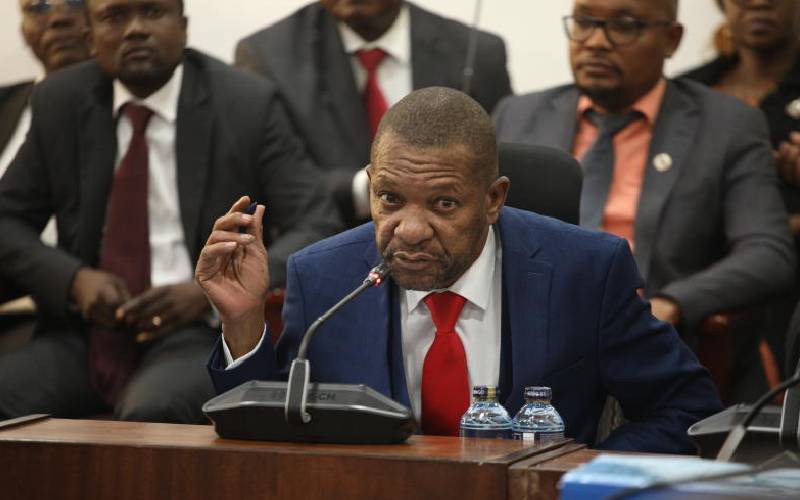
Imagine you're in a huge crowd of people walking down a busy street. You see a person fall to the ground nearby, would you help? Though most people instinctively say yes, research in social psychology tells a different story.
Research suggests that when you are in a group you are less likely to help. It goes further to state that with each person added to the group, individuals feel less inclined to take action.
This is known as the bystander effect. It describes situations in which a group of bystanders witness harm being done, yet do nothing to help or stop the harmful activity.
A recent infamous display of bystander effect was when a man set himself on fire in Mombasa County, at the heart of Mombasa's Mwembe Tayari Area.
The incident, recorded on a 43-second video that went viral, the man was captured pouring an apparently flammable liquid before setting himself ablaze.
He was standing on a block in the middle of a busy road as bystanders watched and others scrambled to capture the moment on their phones.
The man was later rushed to hospital and was treated for at least 50 per cent burns on his back, hands and thighs.
What would have been the outcome if one bystander took action, one might ask? Those on the scene said they had tried to plead with the man not to set himself on fire. It might not have been safe to get closer and intervene but is there something else they could have done?
It's possible that all the bystanders unconsciously believed that someone else would take action and stop the bizarre incident. Perhaps they believed he would not actually go through with it.
According to a US Crime Victimisation Survey report, a bystander was present in 65 per cent of violent victimisations and around 6,500 people out of 10,000 people have witnessed a crime and they did not intervene.
"It is common in an emergency situation and instead of helping they will watch or more likely be taking videos or photos to post on social media platforms. This can be a tragic situation such as a person dying by suicide, assault, drowning or when someone has collapsed or fainted or in the event of an accident," says Dr Geoffrey Wango a counselling psychologist and a senior lecturer at the University of Nairobi.
One of the most powerful parables in our societies is that of a good Samaritan. A man is passing by seeing a stranger lying on the road that many people have passed by and done nothing to help the suffering person, but the man offered assistance, displaying that kindness is a vital aspect in humanity. So we are taught the golden rule, do unto others as you would have them do unto you.
What happens when that good Samaritan rule gets challenged?
The science of empathy will always be an interesting part of human psychology. That empathy depends less on who you are as a person and more on how many people are with you at the time.
In a strange paradox of human nature, the more people there are in a group the less likely anyone is to offer help. After all there is safety in numbers, right? So we believe.
Among the most infamous bystanders are 38 people in Queens, New York, who in 1964 witnessed the murder of one of their neighbours, a young woman named Kitty Genovese.
A serial killer attacked and stabbed Genovese late one night outside her apartment, and these 38 neighbours later admitted to hearing her screams; at least three said they saw part of the attack take place. Yet no one intervened.
While the Genovese murder shocked the world, it also moved several social psychologists to try to understand the behavior of people like Genovese's neighbours.
A silent rule that many live by, especially in metropolitan areas, is don't interact with people, it is inconvenient and risky. We then conform to it and do nothing.
But the bystander effect loses its influence immediately one person takes action, opening a door for assistance that many were hesitating to.
"The first person to take action is mostly rare, it is a gamble one has to take, an act that the bystander is using to gauge if it is safe to engage with the person in need," says Dr Wango a psychologist.
We unconsciously conform to silent rules, especially these two conflicting rules; we ought to help and we ought to do what everybody else is doing.
"And there you are in between groups of strangers, who have not intervened, exerting pressure not to help, it is very difficult to rebel," says Dr Wango.
When someone is in need, people in groups tend to feel they don't need to take action because someone else will take care of it. This is known as the diffusion of responsibility theory, the end results being nobody doing anything.
"People tend to feel a sense of moral responsibility to help or assist someone in distress if they are convinced that they are the only ones present and the only hope. On the other hand, if people are surrounded by others or in a crowd, they're significantly less likely to feel like they have to intervene. This is because it is assumed that since there are several people, someone will assume responsibility and take the first step," says Dr Wango.
"The way to go about it is to suggest that the person who is closest or the first to notice the problem takes immediate action. If you are inexperienced, lack the necessary training or the situation is critical, seek or call for immediate and additional help," adds Dr Wango.
Now that you are aware of the bystander effect, ask yourself, how often do you feel you should help someone but don't because you think somebody else will do it? Bystander effect may be the roadblock that is hindering you from sharing empathy.
 The Standard Group Plc is a multi-media organization with investments in media
platforms spanning newspaper print
operations, television, radio broadcasting, digital and online services. The
Standard Group is recognized as a
leading multi-media house in Kenya with a key influence in matters of national
and international interest.
The Standard Group Plc is a multi-media organization with investments in media
platforms spanning newspaper print
operations, television, radio broadcasting, digital and online services. The
Standard Group is recognized as a
leading multi-media house in Kenya with a key influence in matters of national
and international interest.











